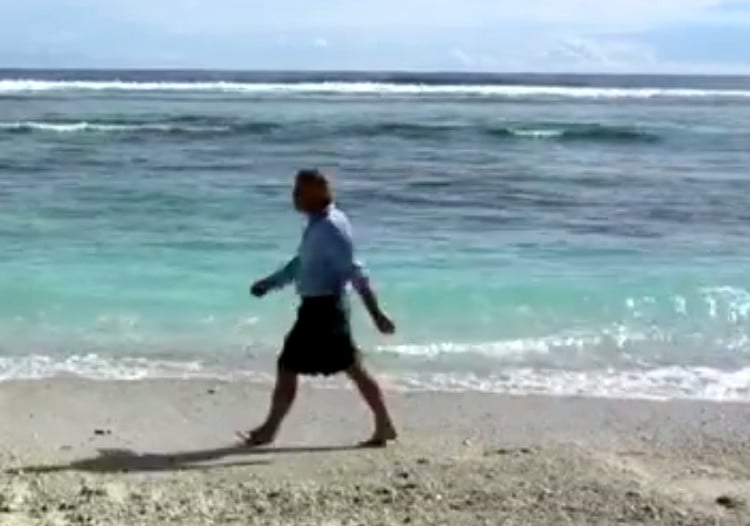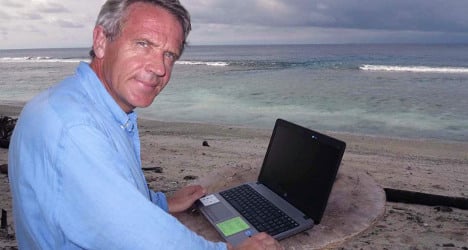Who is Gauthier Toulemonde?
He’s a 54-year-old businessman, publisher and journalist from Lille in northern France.
Why is he in the news this week?
Toulemonde has just returned from a particularly unusual business trip, which the French media have been desperate to hear about.
In the middle of October, he set off on his own for a 40-day trip to a remote, tiny, desert island in Indonesia – surely the most extreme act of telecommuting in business history.
The “WebRobinson” project, as he called it, aimed to “fulfil a boyhood dream,” and to test whether working remotely – very remotely – can really function.
What inspired him to go to such extremes?
Perhaps unsurprisingly to anyone who’s done nine-to-five in a crowded city – it was the daily commute that finally caused Toulemonde to snap.
“I found myself in Gare Saint Lazare [in Paris] last December, watching the continuous flood of people going by,” he told Paris Match, five weeks into his trip.
“They had this sad look on them, even though they were carrying Christmas presents. My idea had been growing for a while, but I decided on that day to leave.”
Another day at the office for Gauthier Toulemonde. Photo: Sophie Fournier/Youtube
Was it easy to plan?
Not exactly. It took him six months to locate the island he would be wilfully stranded on for six weeks, after being turned down by the Indonesian government on several occasions.
In fact, Toulemonde is legally obliged by them not to reveal the exact location of the 700-by-500-metre island, one of 17,000 in the Indonesian archipelago.
When he began his 24-hour journey on October 8th, all he brought with him was four towel-sized solar panels, rations of rice and pasta, a phone and, of course, his laptop.
He set up his tent, which was just strong enough to keep out the torrential rain that afflicted him for several days during the trip, and tried his best to keep the rats, snakes and lizards at bay.
Beyond that, Toulemonde put in six average weeks of work – if we’re only counting man hours.
So how it did go?
Well, Toulemonde got back alive, anyway.
Allowing himself a total budget of €10,000 for the adventure, and €20 a day for internet, Toulemonde told Paris Match that his company Timbopresse was able to publish two editions of “Stamps Magazine” while he was away, by the same deadlines and with the same content as normal.
He would wake at 5am every day, and usually get to bed at around midnight. To bolster his food supplies from time to time, he fished in the sea, and scavenged for vegetables.
Apart from that, though – he worked, sending emails back and forth with his 10 employees 10,000 km away in France.
He made the occasional phone call towards the beginning, but stopped after it became too expensive.

Gauthier Toulemonde, suffering through the daily commute to work. Photo: S. Fournier/Youtube
As productive as he was, did six weeks without seeing or hearing another person not drive him mad?
“Those 40 days, for me it was like being in quarantine,” he told Le Figaro after returning to France. “I used the time as a detox from modern life.”
“What gave me most joy was living – stripped bare – in the closest possible contact with nature. Every day was magical,” he told Paris Match.
What was the worst thing about the trip?
In his own words, he wasn’t too keen on all the rats and snakes, but the only thing he really feared was having his internet cut off.
He admitted, around the 30-day mark, that he did miss seeing other people, and could have gone for a good bowl of moules frites.
So is it possible to go to a desert island on the other side of the planet and still do your job?
Yes, but not indefinitely, says Toulemonde.
“Telecommuting really works,” he told Paris Match excitedly, during the trip. But having completed the full 40 days, the magazine editor and former banker appears to have softened his stance.
“Doing everything virtually has its limits,” he told Le Figaro. “Working from distance might be doable, but nothing can replace human contact,” he concluded.
Do you work from home in France? Do you miss human contact?




 Please whitelist us to continue reading.
Please whitelist us to continue reading.
Member comments